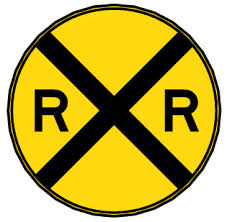 Legal & Safety Blog
Legal & Safety Blog
by Matt Casey
Deadly Train Accident Underscores Importance of Railroad Crossing Safety
This week in Illinois, a van driver failed to yield at a railroad crossing leading to a deadly collision with a freight train that left five elderly people dead. This tragic series of events underscores the importance of obeying railroad crossing signals and exercising caution when electronic signals are not present.
 Operation Lifesaver, a rail safety education initiative, offers these important safety tips:
Operation Lifesaver, a rail safety education initiative, offers these important safety tips:
- Remember to cross train tracks only at designated pedestrian or roadway crossings, and obey all warning signs and signals posted there.
- Not all crossings have electronic signals and gates. When approaching a crossing without mechanical gates or lights, treat it as a stop sign. Always stop, look and listen before you cross the tracks.
- The average locomotive weighs about 400,000 pounds or 200 tons; it can weigh up to 6,000 tons. This makes the weight ratio of a car to a train proportional to that of a soda can to a car. We all know what happens to a soda can hit by a car.
- Trains have the right of way 100% of the time over emergency vehicles, cars, the police and pedestrians.
- Today’s trains are quieter than ever, producing no telltale “clackety-clack.” Any approaching train is always closer, moving faster, than you think.
- Freight trains don’t travel at fixed times, and schedules for passenger trains change. Always expect a train at each highway-rail intersection.
- All train tracks are private property. Never walk on tracks; it is illegal, trespassing and highly dangerous. By the time a locomotive engineer sees a trespasser or vehicle on the tracks it’s too late. It takes the average freight train traveling at 55 mph more than a mile—the length of 18 football fields—to stop. Trains cannot stop quickly enough to avoid a collision.
- A train can extend three feet or more beyond the steel rail, putting the safety zone for pedestrians well beyond the three-foot mark. If there are rails on the railroad ties always assume the track is in use, even if there are weeds or the track looks unused.
- Trains can move in either direction at any time. Sometimes their cars are pushed by locomotives instead of being pulled, which is especially true in commuter and light rail passenger service.
- Stay alert around railroad tracks. No texting, headphones or other distractions that would prevent you from hearing an approaching train; never mix rails and recreation.
Train accidents are horrific. They leave behind a literal physical path of destruction and figurative mental path of destruction. The days and weeks that follow are often a blur, when families are preoccupied with their critically injured or lost loved one and not with the accident itself.
Determining the cause and fault of a train accident is a very complex process. It is critical for victims and their families to have an experienced train accident lawyer on their side to help navigate the aftermath of a train crash. If you or a loved one have been injured or killed in a train accident, the best course of action is to seek help from a personal injury lawyer experienced in handling train accidents.
Partners Matt Casey and Matt Devoti are personal injury litigators, who together have nearly 40 years of trial experience. They specialize in the following practice areas: car, truck and train accidents, helping victims of impaired/distracted drivers, medical malpractice, birth injuries, product and premises liability, elder care and sexual abuse, Workers’ Compensation and wrongful death. Casey & Devoti proudly serves the greater St. Louis metropolitan area, southeastern Missouri and southern Illinois. Learn more about Casey & Devoti and its rich history of aggressively protecting clients’ rights at www.caseydevoti.com.








